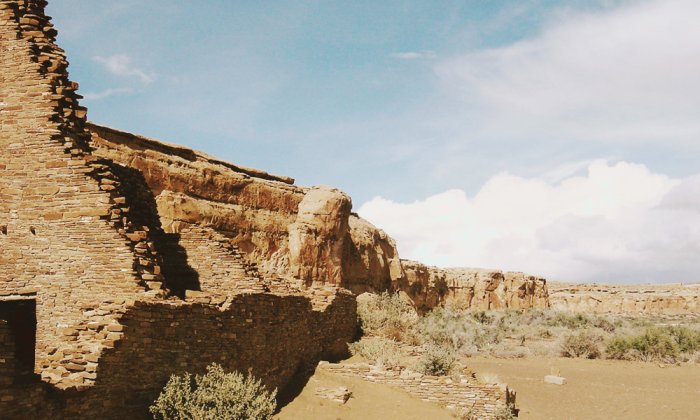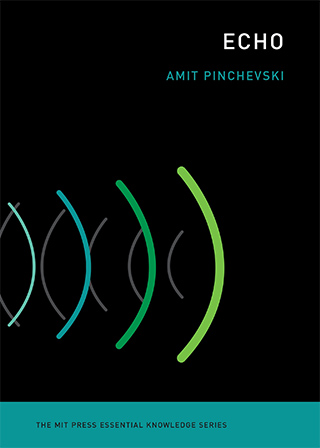If Walls Could Speak: Echoes as a Link to the Past

Many ancient and indigenous cultures revered echo as a supernatural phenomenon. The sound returning from rocks and canyons without apparent source provided ample material for myths and rituals across the world. What for Plato represented an emblem of mistrust, was for prehistoric cultures a source of enchantment. Take the origin myth of the Native American tribe Acoma in New Mexico, which explains how they came to settle where they did. After emerging from the earth, they embarked on a journey following their leader, Masewi, one of twin war heroes, in search for a place, as recorded in an 1895 report of the Bureau of American Ethnology to the Secretary of the Smithsonian Institution:
In their wanderings they would pause at various mesas, thinking perhaps that they had found A·ko. Masewi would call out in a loud voice “Aaaakoooo-o-o!” If the echo sounded favorable they would settle there for a time to make sure. But if the echo was not “good” they would pass on. . . . When they came to the east point of Acoma, Masewi called out “A-a-a-ko-o-o-o!” and received a perfect echo. “This is Ako,” he announced.
This is echolocation in the habitative sense: The dwelling place is where the echo resides. The story presents a clear call-and-response interchange with a deity, both present and absent, whose comeback marks the cessation of migration and the foundation of settlement. Also in New Mexico is Tse’Biinaholts’a Yałti, “Curved Rock That Speaks,” an amphitheater-shaped cliff in Chaco Canyon, which has been recognized as a place for ceremonial performances by the Navajo people. Acoustic measurements on-site show noticeable reverberations all around, but only one distinctive echo from a single point, which gives the impression that the sound was generated from inside the cliff face. Sites like these later became places of worship and ritual, and in some cases are still today.

Archaeologists have recently begun exploring the acoustic properties of sites where ancient wall paintings were found. The findings reveal a remarkable coincidence with an echo point nearby. Given that cave wall and rock paintings are known to have been part of ritualistic activities in ancient times, the discovery of attendant sound reflections is nothing short of groundbreaking. Distinctive echoes have been recorded in open-air sites and caves across Europe, the Mediterranean, and North America. It has been suggested that paintings of hoofed mammals from the Upper Paleolithic era (roughly 40,000–10,000 years ago) might be related to rock-sound reflection. When making percussive noises the echoes produce sounds similar to galloping horses or a buffalo stampede, which might suggest that the art was drawn in response to the sound effect, perhaps as part of rituals for summoning game. At the Pin de Simon cliff in southern France, there are a number of rock cavities, but noticeable echoes (five repetitions and more) exist only opposite the two containing wall art. Similar results were found in sites in Finland, France, and Italy with paintings dating to the Neolithic era (about 10,000–4,500 years ago). These discoveries have led archaeologists to call for the preservation of the entire areas where sound reflections take place, claiming that wall paintings are not complete in themselves but are indications of prehistoric sites of sound rituals.
If wall paintings are visual markers of ancient echoic rituals, the only way to appreciate what they refer to is by experiencing the echoes on-site.
If archaeologists are correct in their speculations, the discovery of the acoustic properties of ancient sites might recast the past anew through echo. If wall paintings are visual markers of ancient echoic rituals, the only way to appreciate what they refer to is by experiencing the echoes on-site. Impressive as they are, the wall paintings might be pointing to something that their artists had deemed even more impressive, as though indicating “echo is here.” This is a veritable indexical mark, yet one that signifies, bewilderingly, both presence and absence: The acoustic effect is “here” but what creates it remains hidden. It is the acousmatic quality of echo, being heard but not seen, that presumably rendered it supernatural for its hearers.
The rituals held there performed and celebrated the duality that connects the worldly and the spiritual through the repetition of sound. Given that all rituals inherently involve repetition, both within the ritual itself and from time to time, those that revolve around echo are thrice repetitive: They are recurring rituals in which repetitions are performed in celebration of a primordial mythical repetition. When visiting these sites today, one might experience something like a historical short-circuit. Although it is one’s own voice being echoed, it is literally the same echo of yore. Its effect has not faded like the colors of the paintings; it is still present unlike those who had first heard it. They are gone to us just as their mythical ancestors were gone to them. Yet somehow the ritual continues as the echo connects all in absentia. It affords a portal to the bygone by virtue of an indexical performance of repetition and response, simultaneously conjuring up presence and absence — and the presence of absence.
Of the built environment, monumental spaces are probably where sound reflections play a comparable role to that played in ancient cultures. As the philosopher Henri Lefebvre suggested, monumentality pits durability and splendor against temporality and perishability, eliciting the experience of “a total being in a total space.” The acoustic architecture of cathedrals, mausoleums, and amphitheaters typically revolves around a sonic focal point where the horizontal flow of the multitude converts into a vertical ascent to higher power. Those passing through are meant to feel humbled by the structure, while those in power get to occupy the acoustic focal point where their voice is heard booming with the surrounding echoes and reverberations. Delivering a speech in such spaces forces the speaker to slow down to be comprehensible, giving rise to monumental rhetoric. And yet here, too, echo is not without subversive potential. This by reintroducing the laterality of relation as opposed to the perpendicularity of power, and the interjection of the here-and-now as opposed to the monumental appeal to the above-and-beyond.
Consider the Echo Stoa, a sheltered pathway adjacent to the Temple of Zeus in Olympia, Greece, where it is said that an echo could multiply as many as seven times. The echoing may have served the grandeur and elevation of the building, but at the same time, it could also have produced undesirable repetitions (say, gossip repeated from one end to the other), counteracting the intended solemnity of the place. It seems that totality is never fully immune to the frolics of echoes.
What about monuments where such lateral echoes are solicited and encouraged? A 1991 project by architect Hali Weiss, which was among the finalists in the Boston Holocaust Memorial competition, proposed to do exactly that. The project, titled “Echo Chamber,” consisted of a large hollow steel rectangle set flush in the ground, embedded with crisscross lines of clear glass encasing small flames. Covering a third of the designated park area, the monument would invite pedestrians to walk across as their footfalls create echoes and reverberations within the steel rectangle. Weiss explained that the project’s design “recedes from form so that the ineffable can enter in its own way. Conceptually, it juxtaposes fact and mystery, loss and regeneration, technology and nature, the ordinary and the sacred.” This echo chamber is meant to confront the presence of the living with the absence of the victims, to “echo from the wound of people walking across it,” resounding the hollowness below as a way to enact a memorial void within. The project was not chosen partly due to its subtlety and lack of sheer monumentality, which is just as well. For it is exemplary of the antimonumental proclivities that echoes entertain, preferring as it did a human-scale relational experience to an imposing collective somberness.
Both acoustic and metaphorical, echo acts as an agent of memory whose function is to evoke the void left by what had been and is no longer.
More recently built memorials have readily adopted the idea. At the Memorial Site in Bełżec, Poland, visitors walk along a narrow pathway built into a hill with increasingly looming walls on either side, wherein, writes Jacek Małczyński in his article “Trees as Living Monuments at the Museum Memorial Site at Belzec,” “one can clearly hear the echo of one’s footsteps and the cold, concrete walls give a chilling impression.” Similar effects transpire in the “Memory Void” on the ground floor of the Jewish Museum in Berlin, where visitors walk on myriad iron plates cut as faces with mouths aghast, as well as amid the erect monoliths in the Memorial to the Murdered Jews of Europe, also in Berlin. Indeed, echo is a prominent trope in Holocaust memory more generally, frequently invoked in academic scholarship and commemoration practices alike. Both acoustic and metaphorical, echo acts as an agent of memory whose function is to evoke the void left by what had been and is no longer. A most poignant form of memory, this; for more than recall, it evinces the impossibility of re-call by enacting the arrival of an empty delivery. Indexicality is intrinsic to echo’s medial operation between present and past as it confronts the here-and-now with the then-and-gone. Which is another way to describe echo’s mediation here: on the one hand tied the material and concrete, on the other hand extending to the past and the passing.
Amit Pinchevski is Professor in the Department of Communication and Journalism at the Hebrew University of Jerusalem. He is the author of “By Way of Interruption: Levinas and the Ethics of Communication” (Duquesne University Press) and “Transmitted Wounds: Media and the Mediation of Trauma” (Oxford University Press), and “Echo,” from which this article is excerpted.



